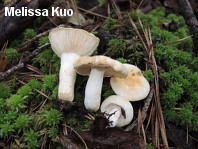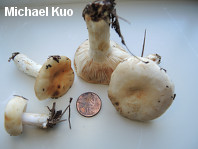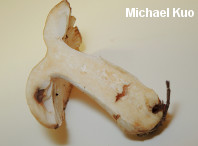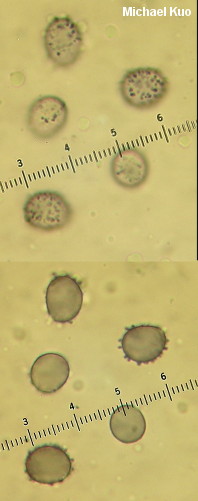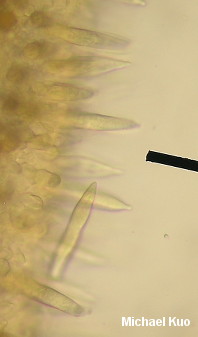| Major Groups > Gilled Mushrooms > Pale-Spored > Russula > Russula crassotunicata |

|
Russula crassotunicata [ Basidiomycota > Russulales > Russulaceae > Russula . . . ] by Michael Kuo The Latin species name for this russula means "thick-shirted," referring to the very thick, rubbery "skin" on the cap surface. Russula crassotunicata would be more difficult to identify, sliding into the anonymous hordes of white and whitish russulas best separated with microscopic examination, if it weren't for the astonishingly thick cuticle. Other features include a very acrid taste, brown staining gills and surfaces, and association with conifers—and, under the microscope, spores featuring crowded, low, isolated warts along with numerous fusiform hymenial cystidia. Russula crassotunicata was originally described (Singer, 1938) from the Pacific Northwest, but versions of it have since been reported from Colorado, the upper Midwest, the northeast, and the Appalachian Mountains, under diverse conifers ranging from hemlocks to pines; it is possible that more than one phylogenetic species is involved. Researchers in 2006 (Machnicki et al.) were able to determine conclusively that Russula crassotunicata is a host for the funky, mycoparasitic Dendrocollybia racemosa; the russula has a "long, persistent decaying period" that provides "nearly year-round substrate for mycosaprobic species," including Dendrocollybia racemosa and Collybia tuberosa. Description: Ecology: Mycorrhizal with conifers, including western hemlock, spruces, and pines; growing alone, scattered, or gregariously; summer and fall; widely distributed in northern North America from the Pacific Northwest to the northeastern United States; also recorded from Colorado. The illustrated and described collection was made under pitch pine in New Jersey. Cap: 3–6 cm; convex, with an incurved margin when young; becoming broadly convex, flat, or shallowly depressed, but usually retaining a slightly tucked-under margin; sticky when fresh and young, but often dry when collected; bald; dull yellowish white; developing brownish stains; the margin not lined; the skin very thick (nearly 1 mm) and rubbery, peeling easily halfway to the center or more. Gills: Broadly attached to the stem; close; whitish; bruising and discoloring brown; short-gills infrequent. Stem: 3–5 cm long; 1–1.5 cm thick; equal; dry; bald; white; bruising and discoloring brown; developing cavities and eventually becoming hollow. Flesh: White; staining slowly brownish, then brown when sliced. Odor and Taste: Odor sweet, suggestive of coconuts; taste quickly, strongly acrid. Chemical Reactions: I have not tested chemical reactions for Russula crassotunicata, but several sources (Shaffer, 1970 & Roberts, 2007) report a green reaction to iron salts for the flesh. Spore Print: White. Microscopic Features: Spores 8–11 x 7–8 µm; ellipsoid; densely covered with amyloid, isolated spines; connectors rare and short; ornamentation 0.25–0.75 µm high. Cheilocystidia 50–65 x 5–7.5 µm; fusiform to cylindric with subacute apices; occasionally constricted once or twice; dull yellow in KOH; abundant. Pleurocystidia similar. Pileipellis very thick; individual elements poorly defined; a tightly packed ixocutis; pileocystidia abundant, cylindric with fusiform apices, ochraceous-refractive in KOH, to about 100 x 10 µm. REFERENCES: Singer, 1938. (Shaffer, 1970; Smith, Smith & Weber, 1979; Phillips, 1991/2005; Roody, 2003; Machnicki et al., 2006; Roberts, 2007; Trudell & Ammirati, 2009.) Herb. Kuo 10101503. This site contains no information about the edibility or toxicity of mushrooms. |
© MushroomExpert.Com |
|
Cite this page as: Kuo, M. (2016, January). Russula crassotunicata. Retrieved from the MushroomExpert.Com Web site: http://www.mushroomexpert.com/russula_crassotunicata.html |
